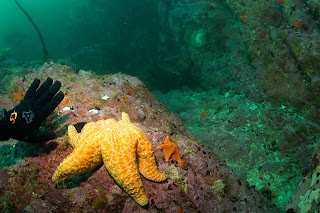On our dive we were really pleased to see lots of large, healthy, Ocher and Spiny (and the usual Bat) stars. It was great to see them back after the wasting disease. We were also pleased to see, not coincidentally, greatly reduced numbers of sea urchins, and some new Palm Kelp growing. On our dive we saw lingcod, cabezon, and rock fish. We also saw a large group of Leafy Hornmouth snails laying eggs. Below are some photos from our dive trip, if you'd like to see more, please go to: https://goo.gl/photos/fG7Pmukv2DHTxBep8
We weren't pleased to find a dead sea lion at the launch ramp as we started out trip, you can see the shark bite crescent....This contributed to my preferring to dive the inner wash rock at Cypress Point because the outer rock is really in deeper, exposed water with no giant kelp right now....but we probably missed seeing passing Gray Whales (and our maybe our mystery echo locator - they've been seeing Orcas frequently..) due to being inside the inner rocks..
Greg gets set for a lingcod shot. As you can see we had very good, about 40 ft visibility. Moderate 51 degree temperature....moderate by local standards!
I had a big smile as I took a quick photo of this well fed Ocher Sea Star with a bat star.
Black and Yellow Rock Fish
Sea urchin horde is greatly diminished and the Palm Kelp is recovering.
Lots of big fat healthy sea stars, hurray!
Greg gets a shot of a group of Leafy Hornmouths laying eggs.
A large group of Leafy Hornmouth snails laying yellow eggs.
The roundish lumps in this picture are large acorn baranacles whose outer shells are buried by strawberry anemones. If you look closely at centers on a couple of them you make out the shell of the barnacle. There's a point to this, if you look 1/3 from bottom and 1/3 from right of photo you can even see the legs of one barnacle out catching plankton. The numbers, density, and size of acorn barnacles are way up since the decimation of large sea stars by the wasting disease four years ago.
Theses are the fresh white skeletons remaining from Acorn Barnacles that have been munched by the beg fat Ocher Sea Stars that are back on the scene. It's a rough neighborhood down there.
See it? Greg takes a shot of a beautiful, well camouflaged Cabezon.
Cabezon do a great job of matching their colors to their surroundings. His red stands out a bit due to my flash. I should have also taken a natural color shot. We scare about half the Cabezon we encounter because we blunder too close without seeing them.












Wow - beautiful colors with the anemones & snail/ eggs! That cabezon sure is well-camouflaged. 51 degrees? Bbbrrrr :-)!
ReplyDeleteLiquid ice! Have you guys dived in New Zealand yet this year?
ReplyDelete